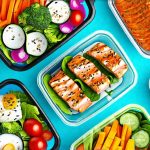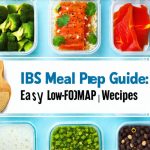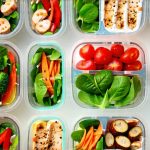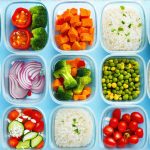Meal preparation – often shortened to “meal prep” – has become synonymous with healthy eating, saving time, and reducing stress in the kitchen. But for many, the idea evokes images of endless chopping, mountains of containers, and a generally overwhelming process. The truth is that meal prep doesn’t have to be a daunting task; it can be enjoyable and even therapeutic when approached strategically. It’s less about rigid adherence to pre-planned recipes and more about creating systems within your kitchen that support efficient food handling and preparation. This article will delve into practical arrangements and organizational strategies designed to transform meal prep from a chore into a manageable, even pleasant, part of your routine.
The key lies in understanding that an effective meal prep setup isn’t necessarily about having a large or expensive kitchen. It’s about maximizing the space you do have and optimizing its functionality. We will focus on creating workflows that minimize steps, reduce clutter, and make the entire process smoother, ultimately encouraging consistency. Many people give up on meal prepping because it feels too hard – often due to poorly arranged kitchens or inefficient routines. Let’s explore how to overcome these hurdles and create a space that fosters culinary confidence.
Zoning Your Kitchen for Efficiency
Kitchen zoning is arguably the most impactful change you can make to improve your meal prep experience. It’s about dividing your kitchen into distinct areas dedicated to specific tasks, streamlining workflow and reducing wasted movement. Think of it like an assembly line; each station has its purpose, and ingredients flow seamlessly from one zone to the next.
The core zones typically include: a receiving/pantry area for groceries, a washing/prep zone for cleaning produce and initial preparation (peeling, chopping), a cooking zone with your stove and oven, a cooling zone for letting cooked food come down in temperature before storing, and finally a packaging/storage zone. Ideally, these zones should be physically separated to prevent cross-contamination and congestion. For example, keep your cutting boards away from the cooking surface. Even in small kitchens, you can mentally delineate these areas – perhaps one corner is designated for prep, while another houses the stove.
Consider where you naturally move when preparing a meal. Do you always reach for produce first? Place your washing/prep zone near the refrigerator. Is the stovetop your go-to? Ensure ample counter space around it. Strategic placement of frequently used tools and ingredients within each zone is crucial. Think about what you use most often during prep – knives, cutting boards, mixing bowls – and keep them readily accessible. This eliminates constant reaching and searching, saving valuable time and energy. Understanding meal timelines can further refine this process.
Optimizing Storage Solutions
Effective storage isn’t just about having enough space; it’s about accessibility and visibility. Traditional cabinets can easily become black holes where ingredients disappear and expire unnoticed. The goal is to create a system that allows you to see what you have at a glance, encouraging you to use up existing items before buying more.
One excellent approach is to utilize clear containers for pantry staples like grains, pasta, and snacks. This not only makes it easier to identify contents but also keeps food fresher for longer. Transferring groceries from bulky packaging into uniform containers maximizes space and creates a visually appealing, organized pantry. For refrigerators, consider using stackable bins or drawer dividers to compartmentalize different types of produce and leftovers. Clear bins are again beneficial – you can quickly see what’s inside without having to rummage through everything.
Don’t underestimate the power of vertical storage. Utilize shelves, over-the-door organizers, and even wall-mounted racks to maximize space in smaller kitchens. Consider investing in pull-out drawers for cabinets; these make it much easier to access items stored deep within. Finally, regularly declutter your pantry and refrigerator, discarding expired or unused items. This prevents clutter from accumulating and ensures that you’re only storing what you actually use. Utilizing meal prep containers is key to this stage.
Knife Skills & Dedicated Prep Tools
Mastering basic knife skills is a game-changer for meal prep efficiency. The ability to quickly and accurately chop vegetables saves significant time and reduces frustration. Invest in a good quality chef’s knife, paring knife, and potentially a serrated bread knife – these three knives will cover most of your chopping needs. Practice makes perfect, so dedicate some time to honing your technique. There are countless online resources offering tutorials on proper knife handling and different cutting styles (dicing, mincing, julienning).
Beyond knives, having dedicated prep tools can streamline the process. A good vegetable peeler, a microplane for grating ginger or citrus zest, and a mandoline slicer for uniform veggie slices are all valuable additions to your kitchen arsenal. Consider investing in a set of nesting mixing bowls; these take up minimal space but offer versatility for various tasks. A sturdy cutting board – ideally one with a groove to catch liquids – is essential. Having multiple cutting boards designated for different food types (meat, vegetables) helps prevent cross-contamination. This ties into kitchen rhythms that help build consistency.
Batch Cooking & Component Meal Building
Batch cooking isn’t just about preparing entire meals in advance; it’s about prepping individual components that can be combined into various dishes throughout the week. For example, roasting a large batch of sweet potatoes or quinoa provides a base for breakfast bowls, salads, and side dishes. Similarly, pre-cooking proteins like chicken breast or tofu saves time when assembling meals later on.
Component meal building focuses on having readily available ingredients that can be easily combined to create different meals. Think about preparing a variety of cooked grains, roasted vegetables, seasoned proteins, and healthy fats (avocado, nuts). This allows you to quickly assemble lunches and dinners without extensive cooking during the week. This approach offers flexibility – you’re not locked into a rigid meal plan but can instead adapt based on your cravings and schedule. Consider strategic layers when combining components to optimize digestion.
Containerization & Smart Food Storage
Choosing the right containers is crucial for preserving freshness and simplifying storage. Glass containers are generally preferred over plastic, as they don’t absorb odors or stains and are more environmentally friendly. Look for airtight lids to prevent leaks and maintain food quality. Invest in a variety of sizes to accommodate different portions and ingredients. Clearly label all containers with the contents and date – this prevents forgotten leftovers from languishing at the back of the fridge.
When cooling cooked food, allow it to cool slightly before transferring it to containers. This prevents condensation buildup, which can lead to soggy food. For longer-term storage in the freezer, use freezer-safe containers or bags. Consider portioning out meals into individual containers for easy grab-and-go lunches and dinners. Finally, rotate your stock – use older containers first to prevent waste and ensure freshness. Learning about liquid meal strategies can also inform storage choices for blended meals. Effective prep also benefits from adopting slow eating routines.


















